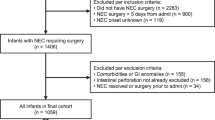Abstract
Objective: We hypothesized that among neonates with necrotizing entercolitis (NEC), important epidemiologic and outcome differences exist between those with early-onset vs. those with late-onset NEC.Methods : We reviewed all records of neonates cared for in the King Fahad University Hospital during the past ten years who had the diagnosis of NEC. We separated cases into two groups depending on age at diagnosis. Specifically, we termed “early-onset” those cases diagnosed during the first seven days of life, and “late-onset” those diagnosed thereafter. We compared, in the two groups, gestational age, clinical signs at onset, laboratory data, surgical findings, complications, and mortality.Results: From 1989 to 1999, 37 cases of stage lla (or higher) NEC were diagnosed; 25 “early-onset “ and 12 “late-onset”. Neonates with “earlyonset” NEC were more mature (35.4 ±2.5 weeks gestation) than those with “late-onset” (27.7 ±2.8 weeks, P = 0.0001), were more likely to have feedings begun in the first 48 hours of life (P = 0.0002), and more likely to have feeding increments of >25 ml/kg/day (P=0.03). Neonates with “late-onset” NEC were more likely to present with vomiting (P=0.003) and apnea (P=0.001), and were more likely to have ileal rather than colonic necrotic lesions, short bowel syndrome, and mortality (P = 0.03).Conclusion: During the past 10 years at the King Fahad University Hospital, cases of early and late-onset NEC have had distinct epidemiologic and outcome features. Recognizing these differences may be useful in prognostication and counseling
Similar content being viewed by others
References
Beeby PJ, Jdffery H. Risk factors for necrotizing enterocolitis: The influence of gestational age.Arch Dis Child 1992; 67:432.
Stoll BJ. Epidemiology of necrotizing enterocolitis.Clin Prenatal 1994; 21: 205–218.
Stoll BJ, Kanto WP, Glass RI. Epidemiology of necrotizing enterocolitis: A case-control study.J Pediatric 1983; 96: 447–451.
Wiswell TE, Robertson CF, Jones TA, Tultle D. Necrotizing Enterocolitis in full-term infants,AJDC 1988; 142: 532–535.
Yaseen H. Khawaja, Okasha I, Mohnnad M, AlUmran K, Al Faraidy A, Al Arfaj A. Necrotizing enterocolitis in term and near term neonates: presentation and out come.Neonatal Intensive Care 1996; 9:17–23.
Walsh and Kliegman R. Necrotizing enter colitis: treatment based on staging criteria.Pediatric Clin 1986; 33:179–201.
Robel TE, Vogtmann C, Faber R. Postnatal intestinal disturbances in small for gestational age premature infants after prenatal homodynamic disturbances.Acta Pediatr 2000, 89: 324–330.
Akinbi H, Abbasi S, Hilbert PL, Bhutani V. Gastrointestinal and renal blood flow velocity profile in neonates with birth asphyxia.J Pediatr 1994; 125: 625–627.
Kamitsuka MD, Horton MK, Williams MA. The incidence of necrotizing enterocolitis after introducing standardized feeding schedules for infants between 1250 and 2500 grams and less than 35 weeks of gestation.Pediatrics 2000; 105: 379–384.
Andrews DA, Sawin RS, Ledbelter DJ, Schaller RT, Hatch E. Necrotizing enterocolitis in term neonates. Am J Surg 1990; 507–509.
Caplan MS, Mackendrick. Inflammatory mediators and intestinal injury.Clin Prenatol 1994; 21: 235–247.
Caplan M, Hsueh W, Kelly A. Serum PAF acetylhydrolase increases during neonatal maturation.Prostaglandin’s 1990; 39: 705.
Limmer J, Gartner L, Kelsch G, Schutze F, Berger D. Diagnosis and treatment of NEC. A retrospective evaluation of abdominal paracentesis and continuous post-operative lavage.Acta Pediatr Supp 1994; 396: 65–69.
Cikrit D, Mastandrea J, West KW. Necrotizing enterocolitis: factors affecting mortality in 101 surgical cases.Surgery 1984; 96: 648.
Author information
Authors and Affiliations
Corresponding author
Rights and permissions
About this article
Cite this article
Yaseen, H., Kamaledin, K., Umran, K.A. et al. Epidemiology and outcome of “Early-onset” vs “Late-onset” necrotizing enterocolitis. Indian J Pediatr 69, 481–484 (2002). https://doi.org/10.1007/BF02722648
Issue Date:
DOI: https://doi.org/10.1007/BF02722648




